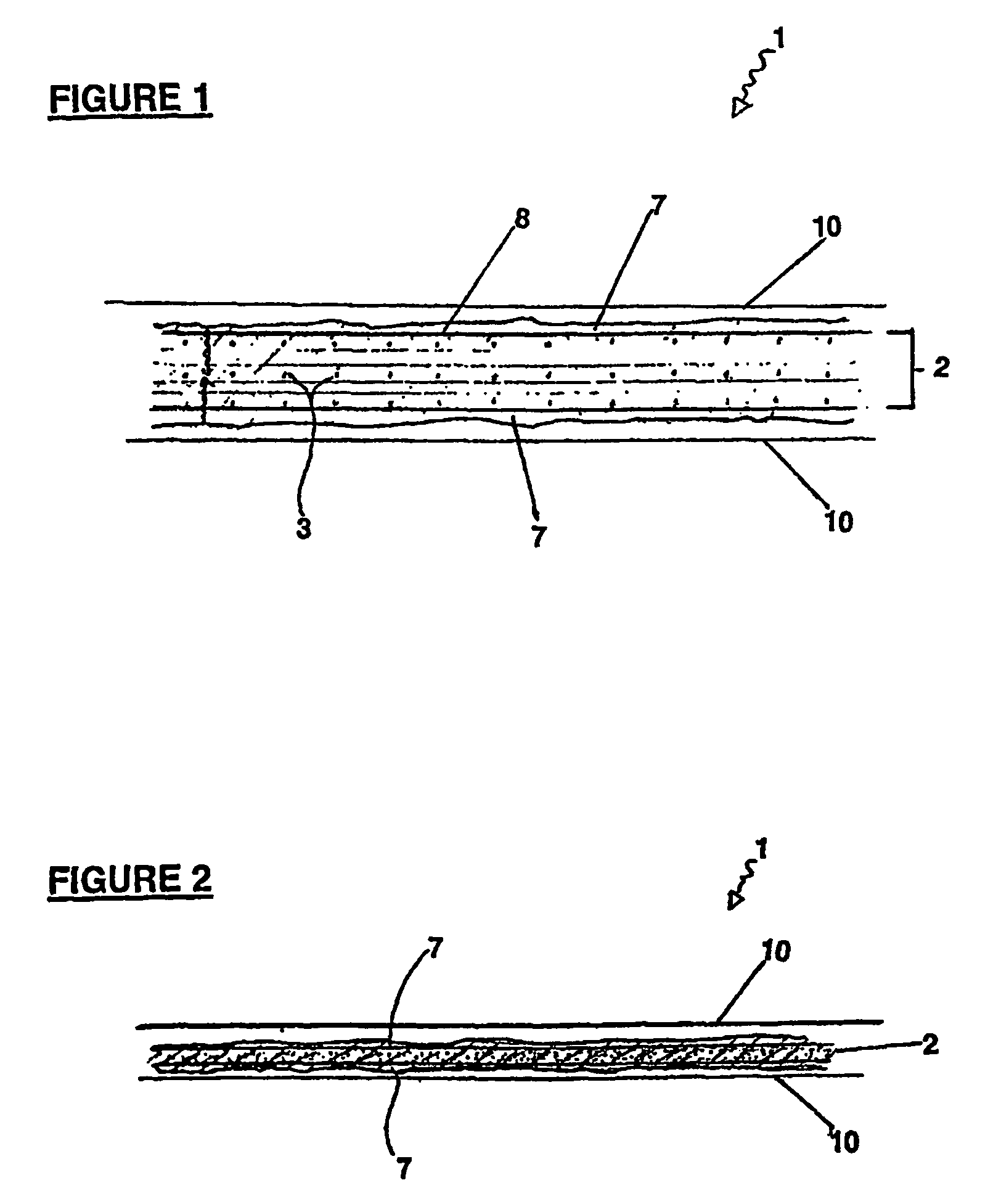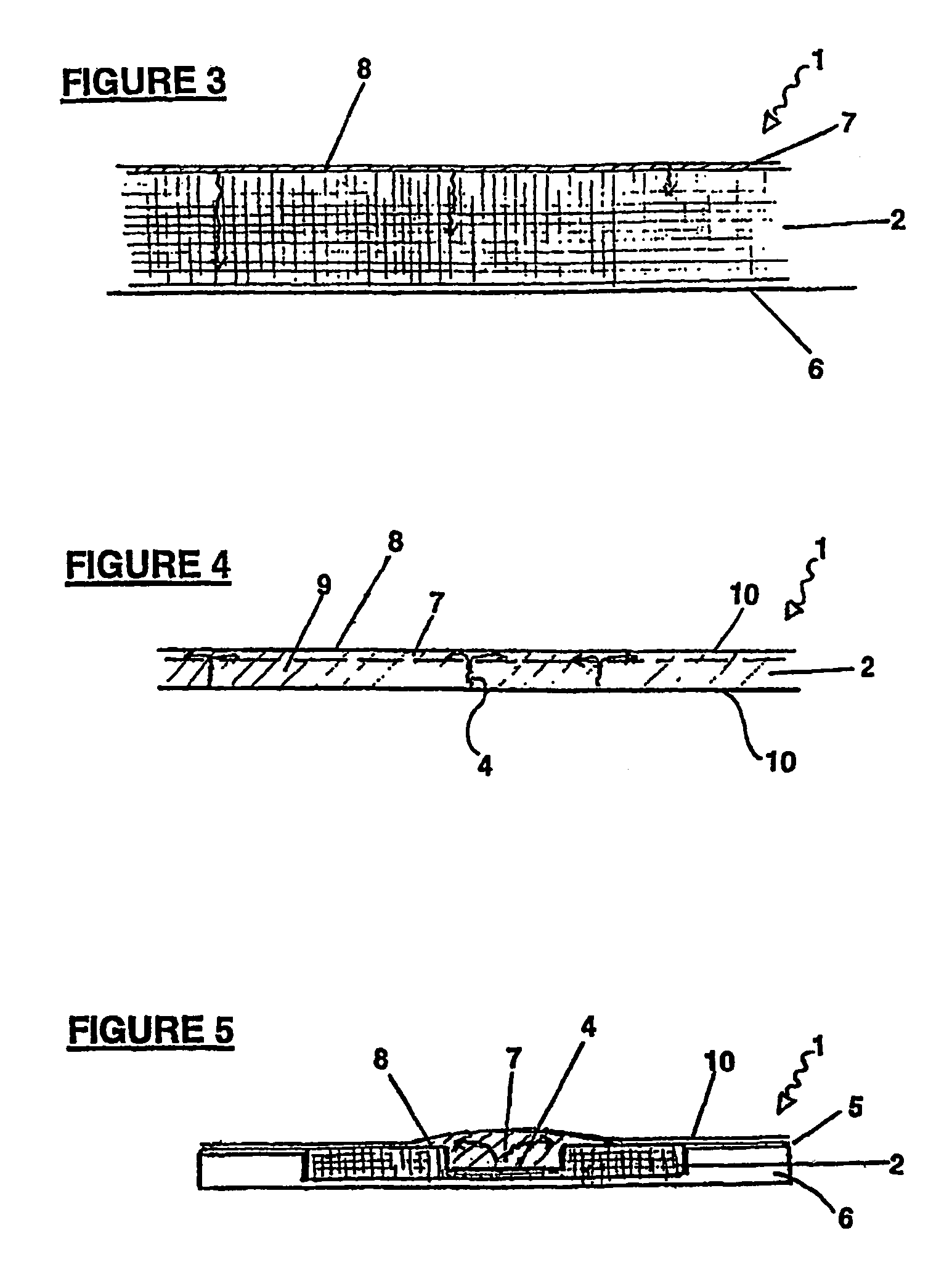Use of honey in dressings
a technology of honey and dressings, applied in the field of use of honey in dressings, can solve the problems of tissue damage, slowing down of healing process, and general use of non-active healing products, and achieve the effects of improving healing, promoting healing of infected wounds, and avoiding the risk of “scabbing”
- Summary
- Abstract
- Description
- Claims
- Application Information
AI Technical Summary
Benefits of technology
Problems solved by technology
Method used
Image
Examples
example 1
1. Preferred Materials
[0126]Preferred quantity of honey by weight required to be applied or impregnate base material to produce a preferred wound dressing. The honey may include varying percentages by weight of creamed or crystallised honey, spray dried, freeze dried, air dried honey and / or liquid honey.[0127]Honey used in relation to the wound dressing may be either or both active honey having preferred non-peroxide, antibacterial / antimicrobial properties, and non-active honey not exhibiting non-peroxide activity.[0128]Optional ingredients including pharmaceuticals (antibiotics, fungicides, other antibacterial agents), vitamin extracts (Vitamin A and so forth), gelling agents, chemical compounds (calcium to promote blood clotting and so forth).[0129]Base material in the form of a film, woven dressing, layered sheet dressing, patch, strap, rope configuration or wrap. Options for the base material include agar gel film, alginate dressing, hydro-colloid, foam dressing, and so forth.
2....
example 2
Preferred Manufacturing Process
[0136]1. The quantities of preferred honey (creamed, crystallised, freeze dried, liquid, spray dried and so forth), are manually mixed together to the required consistency.[0137]Depending upon whether or not the honey composition is to be used in relation to infected or non-infected wounds, the proportion of active to “non-active” is determined. A high active honey concentration will be required for the treatment of infected wounds.[0138]Mixing is undertaken preferably at a temperature and relative humidity required to obtain the honey composition having the preferred viscosity.[0139]The use of high temperatures in relation to the mixing of the honey should be avoided particularly where the composition includes active honey, as high temperatures for prolonged period may destroy the active properties. Where a particularly viscous composition is required, lower temperatures and relative humidity's under 75% are preferred.[0140]2. As required, additional ...
example 3
Application of the Wound Dressing to a Wound
[0148]1. The wound to which the dressing is to be applied is identified and may or may not be “cleaned” before the dressing is applied. Where the wound is infected, preferably the honey composition-base material wound dressing will comprise a high proportion of active honey alone or in conjunction with other pharmaceuticals, agents, compounds.[0149]Where the wound is not infected, the honey composition-wound dressing may comprise a high proportion of non-active honey composition alone, may comprise either or both non-active and active honey composition, alone, or in conjunction with other compounds, agents and so forth.[0150]2. Where the wound is exudating, use of moist wound healing principles may be applied using a wound dressing of the present application that comprises a base material fully impregnated with honey composition providing moisture on all surfaces.[0151]Where the wounds are not exudating, less moist wound dressings may be a...
PUM
| Property | Measurement | Unit |
|---|---|---|
| flexible | aaaaa | aaaaa |
| viscosity | aaaaa | aaaaa |
| fluidity | aaaaa | aaaaa |
Abstract
Description
Claims
Application Information
 Login to View More
Login to View More - R&D
- Intellectual Property
- Life Sciences
- Materials
- Tech Scout
- Unparalleled Data Quality
- Higher Quality Content
- 60% Fewer Hallucinations
Browse by: Latest US Patents, China's latest patents, Technical Efficacy Thesaurus, Application Domain, Technology Topic, Popular Technical Reports.
© 2025 PatSnap. All rights reserved.Legal|Privacy policy|Modern Slavery Act Transparency Statement|Sitemap|About US| Contact US: help@patsnap.com



